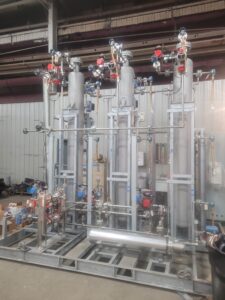
Wintek SN 23170: 12 gpm IPA dehydration unit
This Liquid Phase MSDU Design passes a liquid stream of wet alcohol or solvent through a column filled with molecular sieve beads in a process known as molecular sieve dehydration.
The bed of sieve beads adsorbs water molecules from the liquid as it passes through it. This occurs due to polar attraction. The internal surfaces of the molecular sieve adsorbs more of the water as the bulk liquid flows through the column. This continues until the molecular sieves are at capacity, and dried alcohol product (or solvent) exits the column.
This process continues until the sieve becomes saturated with water, at which time the molecular sieve must be changed, or regenerated. Similar to Wintek’s gas phase MSDUs, our liquid phase MSDUs use temperature swing adsorption to regenerate the beads.
Regenerating the sieve typically involves 1) draining the liquid, 2) heating the sieve beads, 3) purging the gas either at pressure or under vacuum, and lastly, 4) cooling the sieve.
Wintek’s Internally Heated Short Path(SP) Design
Wintek’s unique MSDUL Liquid Phase Molecular Sieve design utilizes internal heating for temperature swing adsorption, which offers the following advantages:
- Very Dry Product to less than 10 ppm
- Low energy consumption
- Very high product recovery due to the low purge gas requirements: >99% recovery
- Very high thermal efficiency with the short gas path for thermal transfer
- High thermal efficiency means shorter regeneration cycle
- A shorter regeneration cycle enables higher processing rates
- Fully piped and wired packaged units
- Fully automated, reducing operator
Externally Heated MSDUs
In Externally Heated MSDU Designs, purging hot dry gas (generally Nitrogen) through the bed, or circulating a hot gas with a partial purge heats up the mole sieve beads.
The low heat content of nitrogen (used to heat and cool the bed) and the relatively large amount of energy required to change the temperature of the beds causes externally heated designs to suffer from long regeneration times.
Relatively high purge gas rates which are exhausted with saturated vapors cause this design to suffer from higher emissions even though condensers are used.

